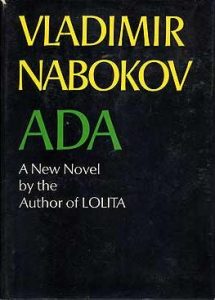
 Literature Guides
Literature Guides
Ada or Ardor Summary
Summary
Ada is largely in written in the form of a memoir by the character Van Veen as he comes into his nineties. He recounts his love for his sister, Ada, in the form of a family chronicle. The novel contains genealogies, dramatic romances, and duels.
Though the novel is posed as a simple memoir, it is fraught with complications, twists, erudite references, puns which cut across multiple languages, and dislocations of time and space. The author’s voice comes through in moments which are deliberately self-conscious, often commenting on the difficulty of writing the book and the book itself. He clams at times that the reader will never understand the book.
The central family plot involves two incestuous generations. The two Durmanov sisters, Aqua and Marina, are married to two first cousins, Dementiy (nicknamed Demon) Veen and Daniel (nicknamed Red) Veen. Though Demon is married to Aqua, he has an extensive liaison with Marina. He and Aqua apparently have a son, Ivan (nicknamed Van), who is actually the son of Demon and Marina.
To hide the scandal, Demon and Marina take advantage of the mentally disturbed Aqua to switch baby Van for Aqua’s stillborn baby. The fertile Marina is also the mother of Demon’s other bastard child, Ada. Marina and Red have another child, Ada’s sister Lucinda (Lucette).
This tangle of relationships serves as the backdrop for the lifelong love affair between two first cousins who are in reality brother and sister. Van and Ada embark on their love affair on the family estate, Ardis, when Van is 14 years old and Ada is 12. Ardis serves as something of a parody of the Garden of Eden and Van and Ada represent a parodic version of Adam and Eve. Arid is located in a magical-realist nineteeth-century United States complete with automobiles, movies, and a fictional town called Lolita, Texas.
Nabokov manages to combine the geographies of Russia and the United States. Ardis Park apparently borders a Russian village called Gamlet filled with Russian “kerchiefed peasant nymphs.” There is a motor court in Utah which has the preserved footprints of Leo Tolstoy. Van and Ada live in the upper world of Terra. The rest of the world is in the lower world of Demonia or Antiterra. These contain the hell of human limitations.
Van is Nabokov’s ideal artist. As a boy he walks around on his hands so he can turn the world upside down. In this way, he resembles the work of the novel itself. Ada is a palindrome. From either side, the name becomes “da,” the Russian word for yes. This is perhaps as a nod to Molly Bloom from Joyce’s Ulysses in which she repeats the word “yes” throughout the novel. The name of the estate, Ardis, brings to mind the expression ars gratis artis which means “art for art’s sake.” All of these ideas are at play in this book.
Ada represents Nabokov’s private myth of human origins. Van is endowed with the poetic talents as a kind of primal man. Ada becomes his sometime collaborator in their later lives. The two of them form a privileged couple with a particular affinity for nature, something Nabokov is drawn to personally.
They spend many years apart after their parents separate while they are quite young. Each spends years indulging in sexual relationships and indulging in all forms of gluttony and callous behavior. Van nearly kills two of Ada’s lovers. He also makes arrangements to blind a servant who threatened to blackmail him and Ada with revealing photographs.
Ada marries into a marriage of convenience with an American Rancher, Andrey Vinelander, at the age of 21. Vinelander dies 29 years later. Lucette, Ada’s half-sister, eventually falls in love with Van, but he refuses to take advantage of her innocence. After Lucette drowns herself in despair Van and Ada are snapped out of their delirium and become aware of the cruelties of the beyond their ideal existence at Ardis.
At this point Van and Ada are free to live there lives together. He is 52 and she is 50 and they must now contend with the fact they are living with physical failings. They also begin to confront the reality of their own mortality. He has become an artist-philosopher and she is a botanist and biologist. They realize that working together can reconcile them to the lost time.
Part 4 of the novel includes a long discourse by Van in which he elaborates on a complex theory of time and space, one that resembles the work of Einstein. He claims that past and present are linked by a series of accumulated images. These are captured by memory. This section resembles Proust’s Remembrance of Things Past even though the text warns us to guard against this conclusion.
We are told to “beware… of the marcel wave of fashionable art; avoid the Proustian bed.” In the end of the novel we are told that most of the novel has been written by Van and Ada; it serves as a prelude to the creation to come, which the book summarizes in its final pages.
The final pages of the novel claim that the book will proceed quickly, even though the book proceeds in slow and often difficult twists and turns. Van and Ada tell us that they love to play Scrabble and they were given the game by Baron Klim Avidov, clearly an anagram of Vladimir Nabokov.



